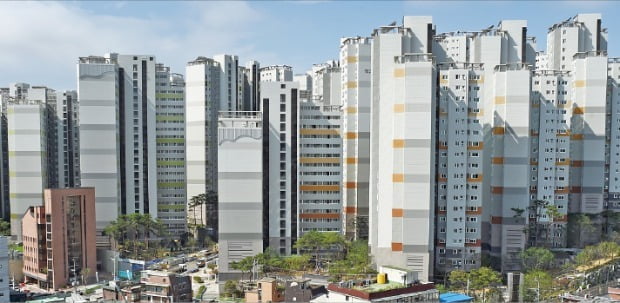
Mapo Raemian Prugio / Photo = Hankyung DB
The rise in house prices, which began with the reconstruction of Apgujeong and Gaepo in Seoul, spreads all over Gangnam, and then spreads to the metropolitan area and provinces through Gangbuk again, which is a typical formula for strong house prices. This is why the government has imposed intensive regulations on Gangnam, especially reconstruction.
This bull market is a sign of reappearance. As the prices of apartments in’Gangnam 3-gu (Gangnam, Seocho, Songpa-gu)’, which had been suppressed by regulations, soared, the prices of houses such as’Mayongseong (Mapo, Yongsan, Seongdong-gu)’ began to wriggle. It is analyzed that concerns about house price anxiety are growing as the buying trend, which was triggered by the jeonse crisis that appeared after the enforcement of the new lease protection law, turned around and converged to Gangnam.
○ As soon as Gangnam rises, Masongseongdo is’excited’
According to the nationwide weekly apartment price trend in the fourth week of December released by the Korea Real Estate Agency (formerly the Korea Appraisal Board) on the 31st, the sale price of apartments in Seoul this week rose 0.06% compared to the previous week. The increase was increased by 0.01 percentage points from last week (0.05%). After’panic buying (panic buying)’ in June-July, apartment prices in Seoul showed a quiet appearance. From the fourth week of August to the end of October, the weekly change rate was only 0.01%. However, the increase rate increased from November, increasing the rate of increase for three consecutive weeks, including △0.03% in the first week, 0.04% in the second week, and 0.05% in the third week.

Gangnam 3-gu is remarkable. This week’s apartment price in Songpa-gu rose 0.11%, ranking first among 25 autonomous districts in Seoul following last week (0.10%). Seocho-gu (0.09% → 0.10%) and Gangnam-gu (0.08% → 0.09%) also expanded from last week. The Real Estate Agency explained, “Songpa-gu was mainly in Sincheon-dong and Munjeong-dong, near Jamsil-dong, which are land transaction permit zones,” and “Seocho-gu showed strong strength mainly in Banpo-dong new construction and Bangbae reconstruction, and Gangnam-gu mainly Apgujeong-dong and Gaepo-dong apartments.”
In particular, the rising trend in the Gangnam area is spreading to the most popular regions after Gangnam, such as Mayongseong. This week, Mapo-gu rose 0.08%, the largest increase except for the southeastern areas of Seoul (Gangnam, Seocho, Songpa, and Gangdong-gu). Yongsan-gu (0.03%→0.05%) and Seongdong-gu (0.02%→0.05%) also increased the width.
The 84 square meters dedicated to the second complex of’Mapo Raemian Prugio’ in Ahyeon-dong, which is called Mapo-gu captain’s apartment, was sold for 1.79 billion won in November, but recently reported for 1.82 billion won. The 83㎡ dedicated to’Raemian Gongdeok 4th’ in Gongdeok-dong was changed to a reported price of 1.5 billion won on the 29th and reached the’loan ban’. The 84㎡ dedicated to’Gangchon’ in Ichon-dong, Yongsan-gu, had no transaction since June (16.30 billion won), but was changed to 1.81 billion won on the 24th. The 84 square meters dedicated to’Hangaram’ nearby were reported at 1.93 billion won, and the 114 square meters dedicated to’Kolon’ were reported at 1.96 billion won.
Kim Gyeong-gyu, head of Korea Investment & Securities Asset Succession Research Institute, said, “When Gangnam 3 districts go up, the next feeder, Ma Yong-seong, shows a pattern that goes up while trying to match the height.” “The buying trend is rushing,” he explained. Go Jun-seok, an adjunct professor at Dongguk University’s Graduate School of Law, predicted, “If this trend is the case, the rise will soon spread to other regions, such as’Nodogang (Nowon, Dobong, Gangbuk-gu), and Geumgwan-gu (Geumcheon, Gwanak, Guro-gu)’.”
○The provinces that are bound by the regulated areas are broken
In December 2020, local metropolitan cities newly designated as regulated areas through the ’12/17 real estate measures’ slowed down. The government newly designated 36 locations, including Paju, Gyeonggi Province, Gongju, Chungnam, parts of Daegu, parts of Ulsan, and Gwangju.
Paju increased from 1.11% (the second week of December) to 0.98% (the third week of December) before the designated area for adjustment, and this week, it was only 0.80%. On December 7, 2020, the 84㎡ exclusive for’Supsokgil Village 3 Complex’ in Munbal-dong, Paju-si, which was traded at 350 million won and updated the reported price, was changed to 319 million won on the 24th of the same month. G-authorized representative Moon Bal-dong said, “As more and more landlords lower bid prices after the announcement of the designation of the target area for adjustment, there are now 310 million won for sale.”
Gongju City, South Chungcheong Province, also saw a sharp decline from 2.31% last week to 0.52% this week. A total of 68 apartment transactions were made in Gongju on December 11-17, just before the designation of the target area, but only 10 transactions were made on the 18-24th after the designation. In addition, Daegu (0.43% → 0.40%), Ulsan (0.62% → 0.60%), and Gwangju (0.29% → 0.18%) also saw a decrease from the previous week.
Real estate experts agreed that it is unclear whether the decline in the rate of increase in house prices in areas newly incorporated as regulated areas will continue. Professor Kwon Dae-jung of the Department of Real Estate at Myongji University emphasized, “As the prices of houses in Seoul, such as Gangnam, are rising through regulations, it is not a situation where local house prices can be relieved.”
Reporter Shin Yeonsu/Jeong Yeonil [email protected]
